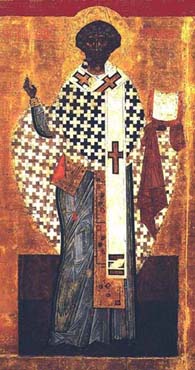December 26-31: The Witness Days
 On the six days between Christmas Day and its Octave on 1 January, we remember five persons who have in various ways, by martyrdom or otherwise, born witness to the truth of the Christian faith.
On the six days between Christmas Day and its Octave on 1 January, we remember five persons who have in various ways, by martyrdom or otherwise, born witness to the truth of the Christian faith.
(Note that the word martyros in pre-Christian Greek means simply "witness," and that it is not always clear whether early Christian uses of it (as in Revelation 2:13) ought to be translated broadly, as "witness", or in the narrow technical sense as "martyr", that is, someone who has explicitly chosen to die rather than to deny Christ as Lord.)
On December 26th, we remember St. Stephen (depicted in the print from the Nurenberg Chronicle), first member of the early Christian church to be put to death for his faith -- see Acts 6,7. He was "a martyr in will and deed."
On December 27th, we remember St. John the Evangelist, one of the Twelve Apostles. It is commonly believed that, although he was imprisoned and beaten for his adherence to Christ, he lived to old age and died a natural death. He was "a martyr in will but not in deed," meaning that he was willing to lay down his life for his Lord, but was not called on to do so -- See M 20:20-28 = P 10:35-45.
On December 28, we remember the Holy Innocents, the children of Bethlehem who were slaughtered by command of King Herod lest one of them prove a danger to his throne -- see M 2:16-18. They were "martyrs in deed, though not in will," and their deaths are a disquieting reminder that suffering on behalf of a good cause is not always restricted to those who have a choice in the matter.
The witnesses commemorated on these first three days are all from New Testament times. On the two days following, we commemorate witnesses from a later period in Christian history. Taking them in reverse order of days --
On December 31 we commemorate Sylvester, bishop of Rome from 313 to 335 -- that is, roughly from the Edict of Toleration issued by the Emperor Constantine to the death of the said Emperor, and thus the first bishop of Rome in the days after Christianity ceased to be an illegal and persecuted religion. With his term of office, we enter an era when to become a Christian is no longer to place oneself in automatic danger of being put to death by the government. However...
On December 29, we remember Thomas a Becket, Archbishop of Canterbury, slain in his own cathedral in 1170, for his defiance of King Henry II. The death of Thomas reminds us that a Christian, even when safe from pagans, can be in danger from his fellow-Christians.
Two recent additions to the Calendar are John Wylcif (31 Dec), a pioneer of Bible translation; and Josephine Butler (30 Dec), who came to the assistance and defense of women whom society had, in effect, declared outside its protection. Neither was (in the technical sense) a martyr. Both are witnesses.
In recent years, it has become the practice of some groups of Christians to give the First Sunday after Christmas precedence over the observance of these days, and so to postpone by one day those commemorations falling on or after that Sunday.
Again, presumably to avoid commemorations close to Christmas (just as we avoid them within seven days of Easter Day), some Christian groups have adopted alternate dates for some of these celebrations.
Thomas the Apostle: 3 July
Stephen the First Martyr: 3 August
John the Evangelist: 6 May
The Holy Innocents: 11 January (after the Magi on 6 January)
Thomas a Becket: 7 July
On January 1st, we celebrate the Circumcision of Christ. Since we are more squeamish than our ancestors, modern calendars often list it as the feast of the Holy Name of Jesus, but the other emphasis is the older. Every Jewish boy was circumcised (and formally named) on the eighth day of his life, and so, one week after Christmas, we celebrate the occasion when Our Lord first shed His blood for us. It is a fit close for a week of martyrs, and reminds us that to suffer for Christ is to suffer with Him.
Copied from http://elvis.rowan.edu/~kilroy/JEK/12/26b.html





